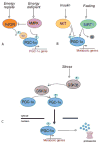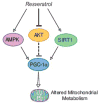PGC-1alpha in aging and anti-aging interventions
- PMID: 19371772
- PMCID: PMC2743759
- DOI: 10.1016/j.bbagen.2009.04.005
PGC-1alpha in aging and anti-aging interventions
Abstract
Deregulation of mitochondrial function is a common feature in multiple aspects of aging. In addition to playing a role in aging-associated disease, decline in mitochondrial energy metabolism is likely to be important in the development of metabolic disease. Furthermore, altered mitochondrial function is a conserved feature in caloric restriction--a dietary intervention that delays aging in diverse species. The transcriptional co-activator PGC-1alpha is a critical regulator of mitochondrial energy metabolism and biogenesis. PGC-1alpha is uniquely poised as a potential target for correcting the effects of age on mitochondrial decline. We describe the cellular and tissue specific mechanisms of PGC-1alpha regulation and illustrate how these pathways may be involved in the aging process.
Figures




Similar articles
-
Resveratrol and SRT1720 Elicit Differential Effects in Metabolic Organs and Modulate Systemic Parameters Independently of Skeletal Muscle Peroxisome Proliferator-activated Receptor γ Co-activator 1α (PGC-1α).J Biol Chem. 2015 Jun 26;290(26):16059-76. doi: 10.1074/jbc.M114.590653. Epub 2015 May 18. J Biol Chem. 2015. PMID: 25987562 Free PMC article.
-
Mitochondrial biogenesis: pharmacological approaches.Curr Pharm Des. 2014;20(35):5507-9. doi: 10.2174/138161282035140911142118. Curr Pharm Des. 2014. PMID: 24606795
-
Effect of resveratrol on mitochondrial function: implications in parkin-associated familiar Parkinson's disease.Biochim Biophys Acta. 2014 Jul;1842(7):902-15. doi: 10.1016/j.bbadis.2014.02.010. Epub 2014 Feb 25. Biochim Biophys Acta. 2014. PMID: 24582596
-
Regulation of mitochondrial biogenesis and PGC-1α under cellular stress.Mitochondrion. 2013 Mar;13(2):134-42. doi: 10.1016/j.mito.2013.01.006. Epub 2013 Jan 22. Mitochondrion. 2013. PMID: 23347985 Review.
-
PGC-1α at the intersection of bioenergetics regulation and neuron function: from Huntington's disease to Parkinson's disease and beyond.Prog Neurobiol. 2012 May;97(2):142-51. doi: 10.1016/j.pneurobio.2011.10.004. Epub 2011 Nov 9. Prog Neurobiol. 2012. PMID: 22100502 Free PMC article. Review.
Cited by
-
Dietary restriction, mitochondrial function and aging: from yeast to humans.Biochim Biophys Acta. 2015 Nov;1847(11):1434-47. doi: 10.1016/j.bbabio.2015.05.005. Epub 2015 May 12. Biochim Biophys Acta. 2015. PMID: 25979234 Free PMC article. Review.
-
Increased superoxide in vivo accelerates age-associated muscle atrophy through mitochondrial dysfunction and neuromuscular junction degeneration.FASEB J. 2010 May;24(5):1376-90. doi: 10.1096/fj.09-146308. Epub 2009 Dec 29. FASEB J. 2010. PMID: 20040516 Free PMC article.
-
GLP-1 (7-36) amide restores myocardial insulin sensitivity and prevents the progression of heart failure in senescent beagles.Cardiovasc Diabetol. 2014 Jul 31;13:115. doi: 10.1186/s12933-014-0115-x. Cardiovasc Diabetol. 2014. PMID: 25078106 Free PMC article.
-
Contribution of PGC-1α to Obesity- and Caloric Restriction-Related Physiological Changes in White Adipose Tissue.Int J Mol Sci. 2021 Jun 2;22(11):6025. doi: 10.3390/ijms22116025. Int J Mol Sci. 2021. PMID: 34199596 Free PMC article. Review.
-
The Role of Exercise in Cardiac Aging: From Physiology to Molecular Mechanisms.Circ Res. 2016 Jan 22;118(2):279-95. doi: 10.1161/CIRCRESAHA.115.305250. Circ Res. 2016. PMID: 26838314 Free PMC article. Review.
References
-
- Masoro EJ. Physiology of aging. Int J Sport Nutr Exerc Metab. 2001;11(Suppl):S218–222. - PubMed
-
- Lee CK, Klopp RG, Weindruch R, Prolla TA. Gene expression profile of aging and its retardation by caloric restriction. Science. 1999;285:1390–1393. - PubMed
-
- Lee CK, Weindruch R, Prolla TA. Gene-expression profile of the ageing brain in mice. Nat Genet. 2000;25:294–297. - PubMed
-
- Park SK, Prolla TA. Lessons learned from gene expression profile studies of aging and caloric restriction. Ageing Res Rev. 2005;4:55–65. - PubMed
Publication types
MeSH terms
Substances
Grants and funding
LinkOut - more resources
Full Text Sources
Other Literature Sources
Medical

